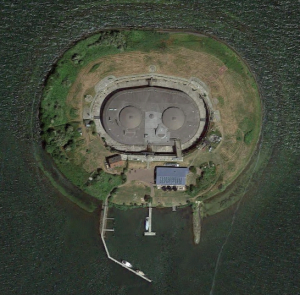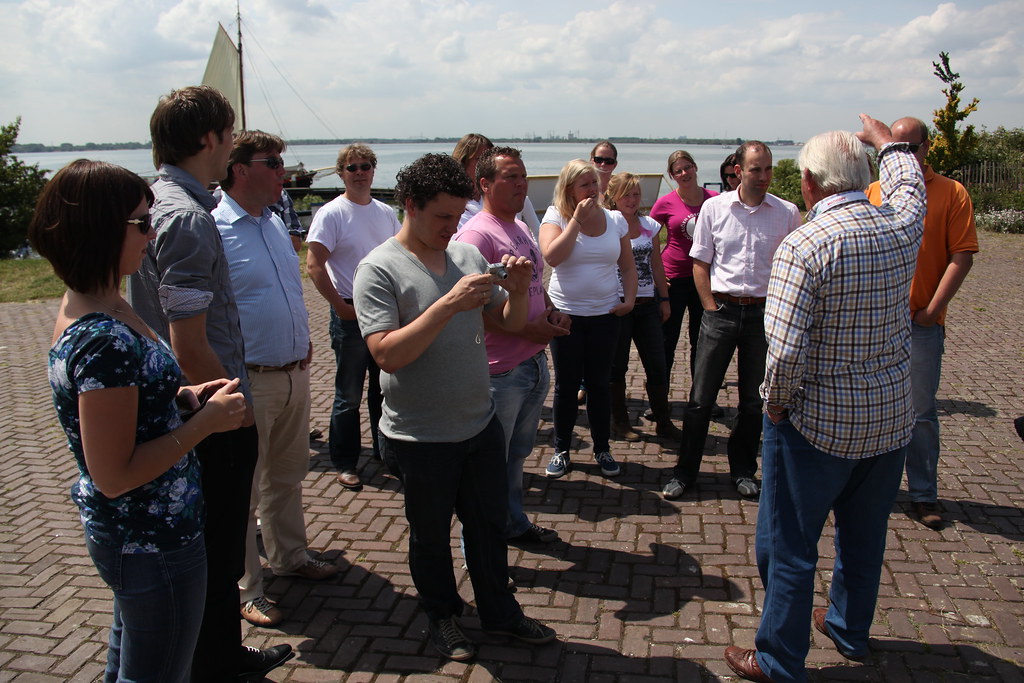Another Weird Island In Dutch Waters – Forteiland Pampus Posted by Sten on Mar 26, 2016 in Culture, Dutch Language, Dutch Vocabulary
Another weird island in Dutch waters! Previously, I talked about the weird “eye” in the IJsselmeer, the IJsseloog.
Now, I have discovered that there is another such a weird island in the Netherlands! It is a weird oval, in the middle of the IJmeer, with a weird grey oval on top of it… Who made this island, now? Aliens this time? No? Still not? Then who made it, and why?
For other posts in the series Strange Places in the Netherlands, click here.
This is Forteiland Pampus (Fort Island Pampus)!
Now, what is this little island doing there, all alone in the IJmeer?
1. How it got there
Between 1887 and 1895, the city of Amsterdam built this island with its fort. It is in the IJmeer, right outside the city of Amsterdam, in order to defend the city in case of an attack from the IJmeer. The name Pampus comes from the zandbank (sandbank) that the fort was built on.
It was part of a bigger military plan to secure the city, the Stelling van Amsterdam. Amsterdam was to be the last resort of the Netherlands. To delay enemies trying to invade the city, large parts would have been flooded, deep enough to keep the soldiers from wading through, and shallow enough for ships to cruise through. Genius!
However, the Stelling and Forteiland Pampus were never needed, and quickly became obsolete with the rise of the airplane. In the first World War, the fort was manned, but the soldiers never had to come in action. The Stelling as a whole, though, served to deter the Germans from invading in the war. In peaceful times, the only person on the island is the fort manager.
In the second World War, however, things changed. The fort was robbed of its metal by the German occupants, and later of its wood by freezing Dutch people in the Hongerwinter of 1944, when people had nothing else to warm themselves with. They could reach the island in that time over the frozen IJmeer.
After the war, the island fell apart. It was plundered and painted with graffiti. However, it was home to some wild student parties in the 1960s…
At the end of the 1980s, the Stichting Forteiland Pampus (Foundation Fort Island Pampus) wanted to save the fort, and in 1990, the Dutch government gave the Foundation the island to do just this.
2. Pampus Today
Today, the island is a wonderful tourist attraction (which you can see in the video above), and it can even be rented for parties, marriages or other events!
3. Saying Voor Pampus liggen
In the Dutch language, there is the saying voor Pampus liggen (lying in front of Pampus). If somebody ligt voor Pampus, this means that that person is exhausted, or just lying there lazily. And this saying comes from the zandbank that the fort was built on!
Back in the days, the sandbank Pampus was an annoying obstacle for ships wanting to to get into Amsterdam. They had to wait in front of the zandbank for flood to come, so they could get over the sandbank without getting stuck. And the lying around there, in front of the city, doing nothing at all – that is just lying in front of Pampus.
I hope you enjoyed the post!
Sten

Build vocabulary, practice pronunciation, and more with Transparent Language Online. Available anytime, anywhere, on any device.
About the Author: Sten
Hi! I am Sten, both Dutch and German. For many years, I've written for the German and the Dutch blogs with a passion for everything related to language and culture. It's fascinating to reflect on my own culture, and in the process allow our readers to learn more about it! Besides blogging, I am a German-Dutch-English translator, animator and filmmaker.







